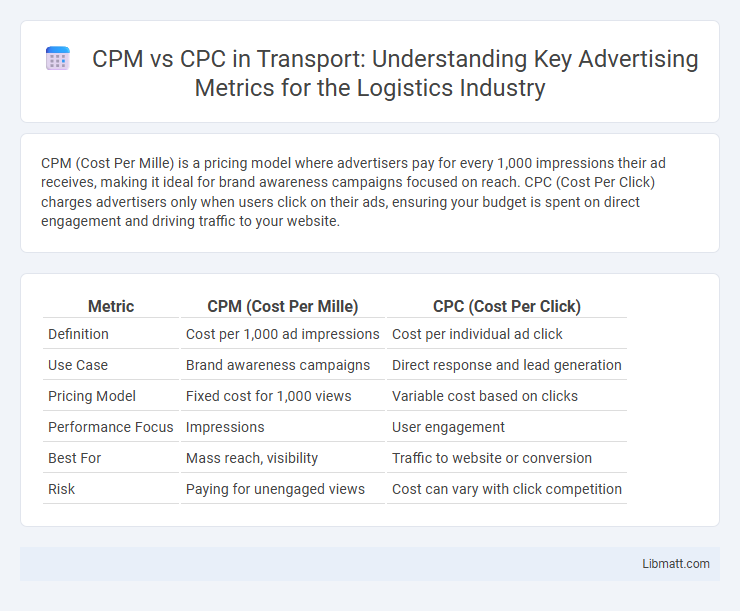CPM (Cost Per Mille) is a pricing model where advertisers pay for every 1,000 impressions their ad receives, making it ideal for brand awareness campaigns focused on reach. CPC (Cost Per Click) charges advertisers only when users click on their ads, ensuring your budget is spent on direct engagement and driving traffic to your website.
Table of Comparison
| Metric | CPM (Cost Per Mille) | CPC (Cost Per Click) |
|---|---|---|
| Definition | Cost per 1,000 ad impressions | Cost per individual ad click |
| Use Case | Brand awareness campaigns | Direct response and lead generation |
| Pricing Model | Fixed cost for 1,000 views | Variable cost based on clicks |
| Performance Focus | Impressions | User engagement |
| Best For | Mass reach, visibility | Traffic to website or conversion |
| Risk | Paying for unengaged views | Cost can vary with click competition |
Understanding CPM and CPC: Basic Definitions
CPM (Cost Per Mille) measures the cost an advertiser pays for one thousand ad impressions, focusing primarily on brand awareness and reach. CPC (Cost Per Click) charges advertisers only when a user clicks on the ad, emphasizing direct engagement and conversion potential. Understanding these basic definitions helps you choose the most effective pricing model based on your campaign goals.
How CPM Works: Cost Per Mille Explained
CPM (Cost Per Mille) charges advertisers based on every 1,000 ad impressions, focusing on views rather than clicks, making it ideal for brand awareness campaigns. Advertisers pay a fixed rate for each batch of 1,000 impressions regardless of user interaction, optimizing reach over direct engagement. CPM is effective in measuring ad exposure and maximizing visibility across digital platforms such as websites, social media, and video streaming services.
How CPC Works: Cost Per Click Explained
Cost Per Click (CPC) is an online advertising model where advertisers pay a fee each time a user clicks on their ad, making it ideal for driving direct traffic and measurable engagement. CPC works by setting a maximum bid for each click, competing in real-time auctions to display ads on search engines or websites, thereby controlling costs and maximizing ROI. Understanding CPC allows you to optimize your ad spend by targeting specific keywords and audiences that are most likely to convert.
Key Differences Between CPM and CPC
CPM (Cost Per Mille) charges you based on every 1,000 ad impressions, making it ideal for brand awareness campaigns aiming to maximize reach. CPC (Cost Per Click) requires payment only when users click on your ad, ensuring you pay for direct engagement, usually suited for performance-driven goals. Understanding these key differences helps you choose the best model aligned with your advertising objectives.
Pros and Cons of CPM Advertising
CPM advertising offers cost-effective brand exposure by charging advertisers per thousand impressions, making it ideal for campaigns aimed at increasing visibility and awareness. However, it may result in lower engagement since advertisers pay regardless of user clicks, potentially leading to less targeted audience interaction. CPM is best suited for brands with broad reach goals but less effective for those prioritizing direct response or conversion metrics.
Pros and Cons of CPC Advertising
CPC advertising charges you only when a user clicks on your ad, making it a cost-effective method for driving targeted traffic and ensuring budget efficiency. Its pros include precise measurement of campaign ROI and high engagement potential, while cons involve potential click fraud and unpredictable costs during competitive bidding. Understanding CPC's strengths and challenges helps you optimize advertising strategies for maximum impact.
When to Choose CPM Over CPC
Choose CPM (Cost Per Mille) when your primary goal is brand awareness and reaching a broad audience with high impression volume. CPM is ideal for advertisers aiming to maximize visibility and frequency rather than immediate clicks or conversions. Campaigns focused on promoting new products, events, or increasing general market presence benefit most from CPM pricing models.
When to Choose CPC Over CPM
Choose CPC over CPM when your goal is to drive direct user actions such as clicks, conversions, or website visits, ensuring you pay only for actual engagement. CPC is ideal for campaigns focused on performance metrics and measurable ROI, especially in competitive markets or when targeting specific audience actions. Your budget efficiency increases as CPC minimizes spend on impressions that do not generate interaction, making it perfect for small businesses or performance-driven digital marketing strategies.
CPM vs CPC: Impact on ROI and Campaign Goals
CPM (Cost Per Mille) optimizes for brand awareness by charging per thousand impressions, making it ideal for campaigns focused on reach rather than direct conversions. CPC (Cost Per Click) directly ties costs to user engagement, enhancing ROI for performance-driven campaigns targeting clicks and conversions. Choosing between CPM and CPC depends on specific campaign goals, with CPM better for broad visibility and CPC maximizing measurable action and return on investment.
How to Decide: CPM or CPC for Your Marketing Strategy
Choosing between CPM (Cost Per Mille) and CPC (Cost Per Click) depends on your campaign goals and budget efficiency. CPM is ideal for brand awareness campaigns where impressions matter most, while CPC suits performance-driven strategies focused on driving direct user actions. Analyze your target audience behavior, conversion rates, and ROI metrics to determine which model maximizes your marketing impact and cost-effectiveness.
CPM vs CPC Infographic

 libmatt.com
libmatt.com